- Learning time
- 30 minutes
- First play time
- 180 minutes
Terraforming Mars
Designed by: Jacob Fryxelius
In Terraforming Mars the players represent corporations who are overseeing the transformation of Mars from an inhospitable, freezing desert, into a lush, verdant home for humans. The board shows Mars itself, divided into hexes. The game begins with the temperature at 30 below freezing and the oxygen level at 0%, so through their actions the players need to warm the planet, increase the oxygen to an acceptable level, and cover nine of the hexes with oceans to support life. The other hexes you’ll be placing are greenery and cities. More on those shortly.
Each player has their own player mat that tracks their resources – which come in the form of money, steel, titanium, plants, energy, and heat. Players also start one corporation card, which defines their starting money and will give an additional benefit (they vary). Then players are dealt ten project cards. You can buy as many of these cards as you like for 3 money each, but you want to be reasonably frugal at the start of the game, because you’ll also be paying money to action your cards – getting them out of your hand and onto the table. The actioning of cards is the essence of the game.
At the start of each subsequent round (or generation, to use the game’s nomenclature) players will also produce resources on their player mats equal to their current production level. Then players receive 4 more project cards, and can choose to buy any, or none of them.
Then there’s an action phase, where players can take one or two actions as many times as they want before passing. Cards always have a cost to action in money, but some will also let you pay using titanium or steel. Some demand slightly trickier criteria – either referencing cards you’ve already played, or the current state of the planet itself. Inevitably more expensive cards are more rewarding, but all of them give some kind of benefit – allowing you to place hexes on the board, which reward you with a variety of things depending on where they are placed, or bumping up your production or resources. Some cards also have a destructive element to them, allowing you to target other players’ resources and mess with them. There are other actions that don’t need cards: converting your plant resources into a greenery hex to be placed on the board (increasing oxygen levels), or your heat resources to increase the planet’s temperature. Both actions reward you with a point. There’s also actions you can do simply by paying money – these are shown on the main board; allowing you to improve the planets’ habitability in some way.
You can also burn a card for one money – not very productive, but potentially very helpful in a game of sometimes fine margins.
At the bottom of the main board are milestones and awards. There are five of each but only three can be claimed during a game. The milestones allow someone who has already met the requirement to claim five points for doing so. The awards have an element of risk to them: they reward certain criteria at the end of the game, so it’s possible to pay for the Landlord, for instance (rewarding most-hexes-controlled on the planet) but find someone else beats you to the award when the game finally ends.
When all ocean tiles have been placed and the oxygen and heat levels have reached their maximum, Mars is considered ‘terraformed’ and at the end of the current generation the game ends. Players score for milestones and awards, any points on the cards they have played (not cards in their hand) and hexes controlled on the board: each greenery hex is worth one point, and city hexes are worth a point for every greenery hex they are adjacent to.
The guru's verdict
-
Take That!
Take That!
Moderate. You can be beaten to a hex you wanted, thwarted at the milestones, gazumped at the awards, and potentially targeted by other players cards as well. Definitely a game with some Take That in it, but there's no combat and the main focus is trying to maximize your own business.
-
Fidget Factor!
Fidget Factor!
Heavy on a first play, dropping to moderate, hopefully. It does depend on who you play with...
-
Brain Burn!
Brain Burn!
...because this a game with many decisions. At the start your options are not multitudinous, but as you accrue more and more cards, you have more and more options. AND many of the cards require certain criteria to be played - the planet must be so warm/so cold; the oxygen must be not too high/not too low, and so on. And if you play card X then you can't afford to play card Y, and if you don't play card Y now then someone else might do what you want to do...
-
Again Again!
Again Again!
If you like what Terraforming Mars offers, there is vast variety in the project cards, giving the game lots of replayability.

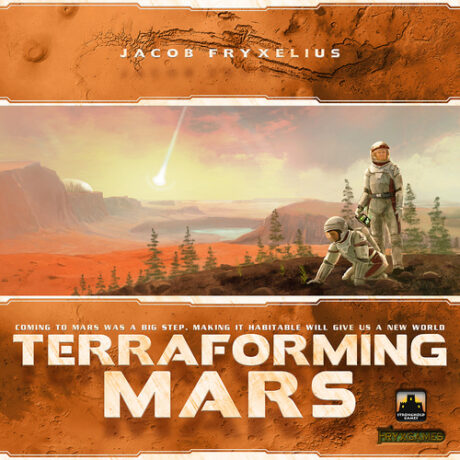
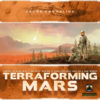
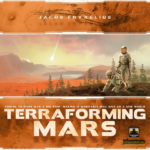
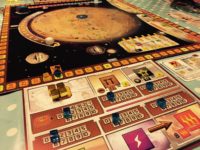
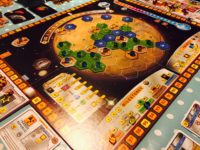
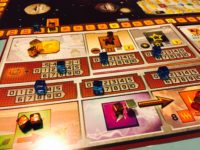
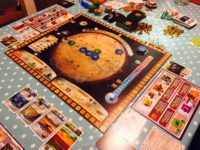


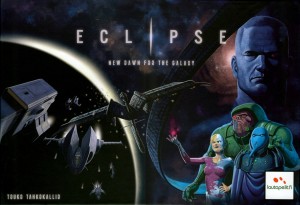
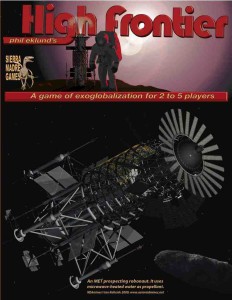
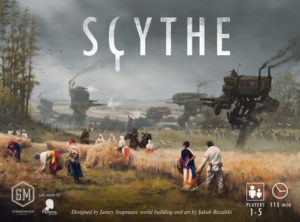
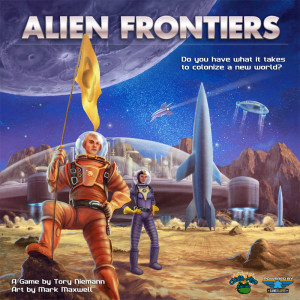
Sam says
Terraforming Mars keeps hold of its theme really well. In some games a theme can feel pasted-on and the experience of playing it is abstract - that's not the case here. You're watching the oxygen and temperature levels and seeing those ocean tiles going down knowing that you're running out of time to action all these lovely cards in your hand. The board - the planet - is transforming before your eyes. And the way the game allows you up to two actions each turn is really neat; plan well and you can pull off a lovely one-two that your opponents won't see coming. It is long and it is complex (there's more than we've covered here, though that complexity rating will drop after a play or two) but it's a very immersive game that I regard highly.